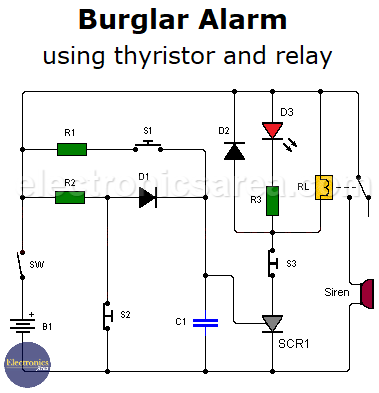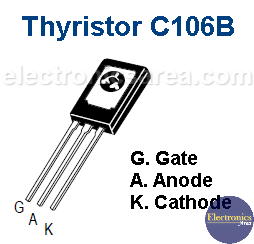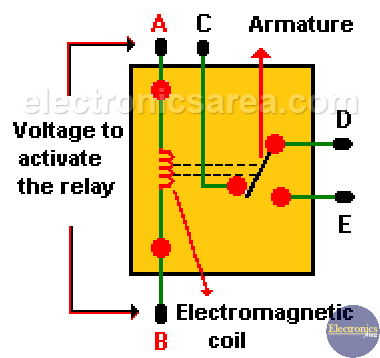Burglar alarm using thyristor and relay
This is a simple Burglar alarm uses a thyristor as the main element and a relay as the output device. The relay can activate a buzzer or a siren.
As a sensor element, we use two different types of switches, one type is normally open (NO) and one normally closed (NC).
In either case, the activation of them causes a trigger voltage to appear on the thyristor gate causing it to conduct, turning on the LED and activating the relay.
How does the Burglar Alarm work?
The alarm circuit is activated:
- When contact S1 is closed, a current flows through resistor R1 causing the voltage in the gate to rise and trigger the thyristor.
- When contact S2 is opened, a current flows through resistor R2 and diode (D1) to the gate triggering the thyristor.
Burglar alarm using thyristor and relay
Any number of contacts can be placed in parallel, in order to protect several access points. You can even place an NA switch and another NC switch in a location near the alarm to prove that the circuit is functioning properly. Sensor elements to be used may be of any type. This depends on where the alarm is installed.
Thyristor C106b Pin distribution
Capacitor C1 is placed between the thyristor gate and ground in order to avoid false alarms.
Once the thyristor is activated, it will remain active. To deactivate the thyristor and the sound of the siren, a momentary NC contact switch is placed in series with the thyristor, so when the alarm sounds, and we wish to deactivate it, we will momentarily press this switch (S3) so that it stops conducting and the siren or bell stops ringing.
Relay (Electromagnetic Switch)
Note that when S3 is pressed, if any of the contacts (S1, S2) are still active, the thyristor will conduct again and the siren or bell connected to the relay will sound.
Thyristor has a maximum current capacity of 4 Amp., sufficient to activate any relay.
List of burglar alarm components
- 1 thyristor (SCR1) C106B
- 1 12V relay (RL)
- 1 common red LED (D3)
- 2 1N4001 semiconductor diodes (D1, D2)
- 2 33K resistors (R1, R2)
- 1 510 ohm resistor (R3)
- 1 0.1 uF (microfarads) capacitor (C1)
- ? Normally open contacts (S1a, S1b, etc.)
- ? Normally closed contacts (S2a, S2b, etc.)
- 1 main switch to power the circuit (SW)







